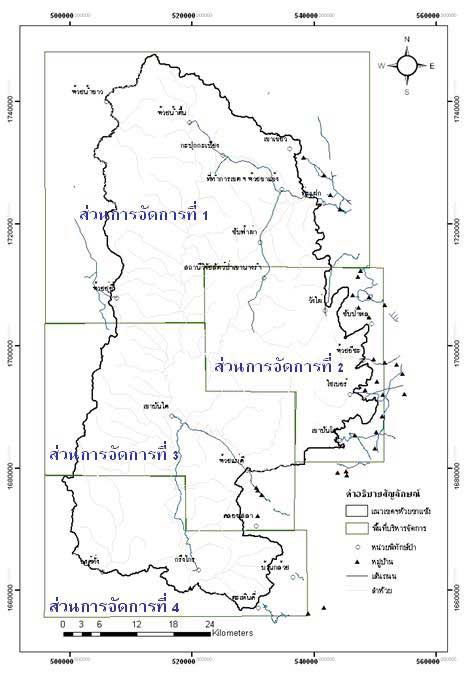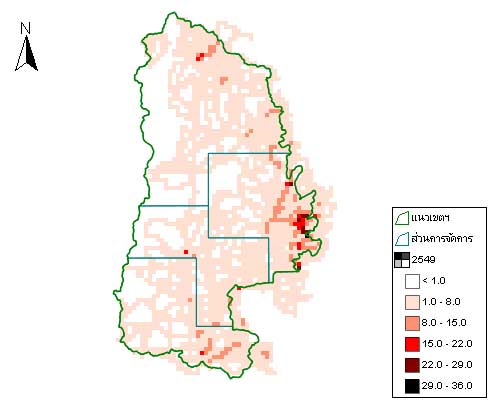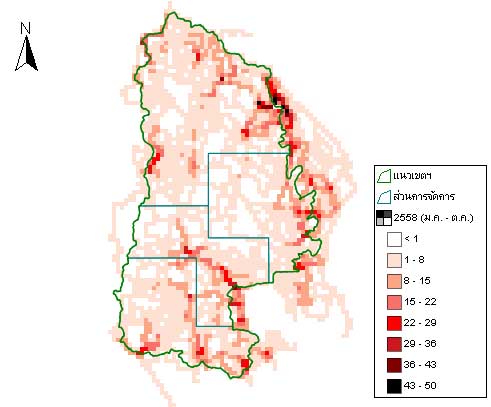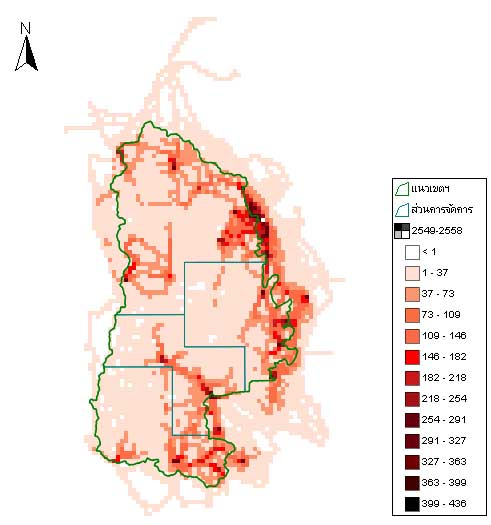In 1972, Huai Kha Khaeng Wildlife Sanctuary (HKK) was made the 5th wildlife sanctuary in Thailand. Together with Thungyai Naresuan Wildlife Sanctuary (TY), HKK was declared the first World Heritage Site in Thailand, covering an area of about 2,780 km2. It is located in the Uthai Thani and Tak provinces in western Thailand. Being that it is a large intact forest, it’s home to several valuable species such as the marbled cat, tapir, serow, and notably the wild water buffalo population which inhabits only HKK. The Indo-Chinese tiger, Asian elephant, banteng, gaur, and Rufous-necked hornbill, among other species residing in HKK, are classified as Vulnerable or Endangered Species by IUCN (International Union for Conservation of Nature and Natural Resources). In addition to being an exemplary place for educating student and others about nature, HKK is a research area for tigers, complete with a law enforcement system with the participation of all sectors.

Management Zones of Huai Kha Khaeng Wildlife Sanctuary
Law Enforcement within the Area
Overall Result
The Smart Patrol System has been continuously developed and refined in HKK since 2005. The patrol database was developed from MIKE (Monitoring Illegal Killing of Elephants), and later developed into MIST (Spatial Management Information System) during 2008-2013. Since 2014, a new patrol database called SMART (Spatial Monitoring And Reporting Tool) has been introduced to various areas to help increase the patrol efficiency with the combination of law enforcement and data management.
In 2006, there were 36 trips in the HKK patrol coverage of a 1 km2 area compared an increase in 2015 of 50 total trips. Overall, patrolling during 2006 to 2015 was spread throughout most of HKK with 436 trips in total, including expansion to a nearby wildlife sanctuary border.
 |  |  |
The Comparison of Patrol Coverage
in 2006 | The Comparison of Patrol Coverage
in 20015 | The Comparison of Patrol Coverage
in during 2006 to 2015 |
HKK patrol performance has been continually improving. Monthly, each patrol team submits their patrol data and reports for their monthly meetings. At the meetings routes, wildlife data, and threats and their solutions are discussed. All data from each patrol team will be further analyzed for the next management plan. In 2011 HKK, Thungyai Naresuan East (TYE) and Umphang (UMP) rangers planned and worked together to arrest tiger poachers. After intelligence gathering, planning, encountering, and fighting with patrol techniques, they finally succeeded in arresting them. One Vietnamese and one Hmong poachers got caught with obvious evidence that linked them to tiger poaching in the sanctuary. This shows that knowledgeable rangers are required for strengthening law enforcement for natural resource protection. This is increasingly important as forest rangers have to confront poachers frequently and have a growing risk of injury or death in action. Accordingly, we need to strengthen the rangers’ patrol techniques in order for them to tackle the dangers from facing poachers effectively and safely, including enhancing their performance for the effectiveness of wildlife protection and threat prevention. Therefore, patrol training under “Law Enforcement Strengthening System” has been initiated in HKK. Students from the Faculty of Forestry of Kasetsart University have been participating in this particular training because the training has been shown very beneficial for their future careers in this particular field. They are able to understand the procedures taught during the course such as patrol techniques to strengthen law enforcement and morale in the work environment.
The training’s lessons include fundamental knowledge of discipline, patrol techniques, evidence and record collection from the scene, investigative techniques, scene inspection, and weapons study (practice and maintenance). The training has been continually supported by WCS and the instructors from the Special Operation Division – Crime Investigation Center of Provincial Police Region 3, the Special Training Division 2 – Border Patrol Police Bureau and the Special Training Division 6 – Border Patrol Police Bureau. Huai Kha Khaeng Wildlife Sanctuary could be the site model for conservation management in other wildlife sanctuaries and national parks in Thailand.
The Smart Patrol Training under the “Law Enforcement Strengthening System”